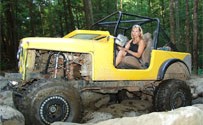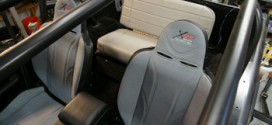Summer is now in full swing and even in the calm Midwestern states, it’s blistering hot. While a hot engine is great for cooking foil wrapped hot dogs and convenience store burritos, it is not so hot (get it? “Not so hot”… we crack ourselves up) for the life expectancy of your engine and transmission.
When we wrote part one of our two-part series entitled “5 steps to a cooler Running Engine”, we had accidentally cured our overheating ails before we could even get to part two. Good for us, but maybe not so good for you folks who needed a few more ideas to keep your mill running at proper temperature. So here are ten more ways to keep your motor running at the proper temp.
Low RPM Cooling
 FlowKooler, maker of high-output automotive water pumps, has increased the number of impeller blades from 8 to 16 blades on twenty of their most popular pumps. What the heck does that mean? With FlowKooler’s patent-pending MiraKool impeller design, it more than doubles the water flow rate at idle, yet drops back to stock output at 3,500 RPM, avoiding too much water flow at higher RPM.
FlowKooler, maker of high-output automotive water pumps, has increased the number of impeller blades from 8 to 16 blades on twenty of their most popular pumps. What the heck does that mean? With FlowKooler’s patent-pending MiraKool impeller design, it more than doubles the water flow rate at idle, yet drops back to stock output at 3,500 RPM, avoiding too much water flow at higher RPM.
By doubling the GPM output, FlowKooler water pumps solve engine overheating at idle. Independent testing by some dudes in lab coats and safety goggles, checked off their handy clip boards to prove that FlowKooler pumps out-perform all other makes at low speeds – Perfect for us off-roaders. FlowKooler offers 70 different high-flow water pumps and all are backed with a limited lifetime warranty.
www.flowkooler.com
Ditch the Flex Fan
 If you have the slightest overheating problems, don’t even consider a flex fan. We’ve tried them, they simply don’t work. They’re great for street cars and hot rods, but they won’t move enough air to properly cool your rig’s mill at idle, low speeds or under load.
If you have the slightest overheating problems, don’t even consider a flex fan. We’ve tried them, they simply don’t work. They’re great for street cars and hot rods, but they won’t move enough air to properly cool your rig’s mill at idle, low speeds or under load.
If you have moderate overheating problems you can get a quality electric puller fan that moves sufficient air from a manufacturer such as Flex-A-Lite.
If you have more severe overheating problems though, your best bet is a heavy-duty, thermostatic clutch fan. The thermostatic fan is controlled by temperature and will engage more aggressively as the temperature rises, and disengages as the temperature lowers. Thermostatic clutch fans are noisy as all get out, but they work very well.
Be aware of swapping in a severe-duty clutch fan though as they typically need greater fan blade clearance than your garden variety standard or heavy duty clutch fan.
www.flex-a-lite.com
Fan Shrouds
|
Transmission Cooling Pans
|
Oil Coolers
|
Timing is Everything
Well, maybe it’s not everything, but it is something, and its part of a good tune up. You can effectively adjust the timing in your older rig to produce a cooler burn, which will drop the engine temperature a few degrees. Finish the tune up with all the usual pieces parts to keep your rig’s motor healthy too.
Wet Water
 WaterWetter, a coolant system additive from Redline, claims coolant temperature reduction as much as 30ºF. We’ve tested it in the past and have seen 5-10ºF drops, but not 30. Regardless, it’s a quick, cheap way to drop several degrees.
WaterWetter, a coolant system additive from Redline, claims coolant temperature reduction as much as 30ºF. We’ve tested it in the past and have seen 5-10ºF drops, but not 30. Regardless, it’s a quick, cheap way to drop several degrees.
www.redlineoil.com/products_coolant.asp
Radiator Flush & Fill
Some folks will swear by the gunk-busting additives you can put into your radiator, which supposedly breaks up calcified deposits and allows your cooling system to run more efficiently. On rare occasion I’ve seen this cause leaks in an already aging cooling system, so I’ve stuck with the principal of simply flushing and replacing my coolant once a year. Use distilled water, it’ll only cost you a few bucks, instead of your garden hose to keep your cooling system as clean as possible. Iron, calcium and other minerals in tap water will, over time, wreak havoc and plug up small passages. While you’re at it, consider using environmentally safe anti-freeze to keep your neighborhood kitty cats safer.
Let it Flow
This may sound ridiculously simple, but keep your vehicles grill clear from obstacles. Those nifty stainless steel grill screens you see on Jeeps are about as worthless as a screen door on a submarine. Like off-road lights and winches mounted too high, they block air flow and greatly reduce your cooling systems ability to cool.
Kick it into Underdrive
 Underdrive pulley systems (smaller pulleys that allow your engine’s alternator, water pump, etc. to spin faster) are generally used to allow your alternator to spin faster and produce maximum power just above idle. However, a great side effect is that the water pump will now spin faster and move more fluid, thereby cooling your engine a bit more efficiently. There is a point however, where you can move too much water too quickly through your radiator and engine, and not give it enough time to effectively cool down, so don’t go underboard… er, overboard. March Performance is a great source for underdrive pulley kits, serpentine conversions and more.
Underdrive pulley systems (smaller pulleys that allow your engine’s alternator, water pump, etc. to spin faster) are generally used to allow your alternator to spin faster and produce maximum power just above idle. However, a great side effect is that the water pump will now spin faster and move more fluid, thereby cooling your engine a bit more efficiently. There is a point however, where you can move too much water too quickly through your radiator and engine, and not give it enough time to effectively cool down, so don’t go underboard… er, overboard. March Performance is a great source for underdrive pulley kits, serpentine conversions and more.
www.marchperf.com
 4x4Review Off Road Magazine
4x4Review Off Road Magazine






